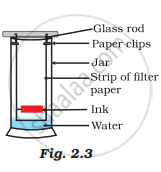Advertisements
Advertisements
प्रश्न
Solve the following problem:
Perform the following calculation. Round off your answer to three digits.
`((9.28xx10^9)(9.9xx10^-7))/((511)(2.98xx10^-6))`
उत्तर
`((9.28xx10^9)(9.9xx10^-7))/((511)(2.98xx10^-6))`
= `0.06033 × 10^(9–7–(–6))`
= 0.06033 × 108
= 6.03 × 106
APPEARS IN
संबंधित प्रश्न
To make a saturated solution, 36 g of sodium chloride is dissolved in 100 g of water at 293 K. Find its concentration at this temperature.
Calculate the amount of carbon dioxide that could be produced when 1 mole of carbon is burnt in 16 g of dioxygen.
A sample of drinking water was found to be severely contaminated with chloroform, CHCl3, supposed to be carcinogenic in nature. The level of contamination was 15 ppm (by mass).
- Express this in percent by mass.
- Determine the molality of chloroform in the water sample.
Dinitrogen and dihydrogen react with each other to produce ammonia according to the following chemical equation:
\[\ce{N2 (g) + 3H2 (g) → 2NH3 (g)}\]
(i) Calculate the mass of ammonia produced if 2.00 × 103 g dinitrogen reacts with 1.00 × 103 g of dihydrogen.
(ii) Will any of the two reactants remain unreacted?
(iii) If yes, which one and what would be its mass?
Calculate the molarity of a solution of ethanol in water in which the mole fraction of ethanol is 0.040 (assume the density of water to be one).
Solve the following problem:
Write the following number in ordinary decimal form:
3.75 × 10−1
Solve the following problem:
Write the following number in ordinary decimal form:
0.011 × 10−3
Solve the following problem:
Write the following number in ordinary decimal form:
14.3 × 10−2
Solve the following problem:
Write the following number in ordinary decimal form:
5.00858585
Solve the following problem:
Perform the following calculation. Round off your answer to two digits.
`(1.4xx10^9)/((2.77xx10^3)(3.76xx10^5))`
Perform each of the following calculations. Round off your answers to three digits.
(3.26104) (1.54106)
Solve the following problem:
Your laboratory partner was given the task of measuring the length of a box (approx 5 in) as accurately as possible, using a metre stick graduated in milimeters. He supplied you with the following measurements:
12.65 cm, 12.6 cm, 12.65 cm, 12.655 cm, 126.55 mm, 12 cm.
Give your reason for rejecting each of the others.
Name the process associated with the following
A drop of ink placed on the surface of water contained in a glass spreads throughout the water.
What are the favourable qualities given to gold when it is alloyed with copper or silver for the purpose of making ornaments?
A child wanted to separate the mixture of dyes constituting a sample of ink. He marked a line by the ink on the filter paper and placed the filter paper in a glass containing water as shown in Fig.2.3. The filter paper was removed when the water moved near the top of the filter paper.
(i) What would you expect to see, if the ink contains three different coloured components?
(ii) Name the technique used by the child.
(iii) Suggest one more application of this technique.

What will be the molarity of a solution, which contains 5.85 g of NaCl(s) per 500 mL?
Which of the following terms are unitless?
(i) Molality
(ii) Molarity
(iii) Mole fraction
(iv) Mass percent
What is the difference between molality and molarity?
The molarity of pure water is ______.
With increase of temperature, which of these changes?
What quantity (in mL) of a 45% acid solution of a monoprotic strong acid must be mixed with a 20% solution of the same acid to produce 800 mL of a 29.875% acid solution?
250 g solution of D-glucose in water contains 10.8% of carbon by weight. The molality of the solution is nearest to ______.
(Given: Atomic weights are H, 1u; C, 12u; O, 16u)
The molality of solution containing 15.20 g of urea, (molar mass = 60) dissolved in 150 g or water is ______.
The molarity of urea (molar mass 60 g mol−1) solution by dissolving 15 g of urea in 500 cm3 of water is ______.
Molarity is ______.
